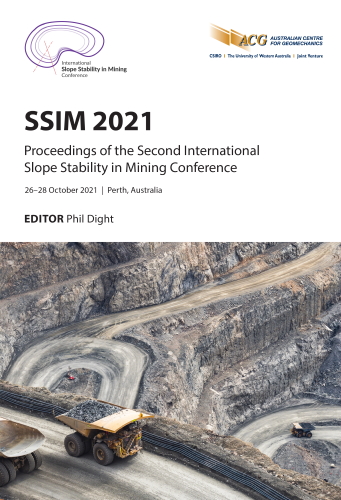Development and application of a reliability-based approach to slope design acceptance criteria at Bingham Canyon Mine

|
Authors: Gaida, M; Cambio, D; Robotham, ME; Pere, V |
DOI https://doi.org/10.36487/ACG_repo/2135_02
Cite As:
Gaida, M, Cambio, D, Robotham, ME & Pere, V 2021, 'Development and application of a reliability-based approach to slope design acceptance criteria at Bingham Canyon Mine', in PM Dight (ed.), SSIM 2021: Second International Slope Stability in Mining, Australian Centre for Geomechanics, Perth, pp. 83-94, https://doi.org/10.36487/ACG_repo/2135_02
Abstract:
In 2009, CSIRO published Guidelines for Open Pit Slope Design (Read & Stacey 2009). As with many highquality guidelines, this publication became broadly accepted as a standard across the surface mining industry. Similarly, Table 1.1 of this guideline, which details typical Factor of Safety and Probability of Failure acceptance criteria values, has been adopted in terms of allowable mine slope design. Following the 2013 Manefay slope failure event at Rio Tinto Kennecott’s (RTK) Bingham Canyon Mine, scrutiny on how pit slopes were designed and approved across Rio Tinto increased, with a heightened focus on data reliability, consequence of slope failure and appropriate design peer review. Given that the mine has been in operation since the early 1900s, it has amassed an enormous amount of geological, geotechnical, hydrogeological, and slope performance data. Based on this data and the quality of RTK’s component geotechnical models, the mine team challenged itself to see what could be done to refine its own in-house process for definition of slope design acceptance criteria. RTK undertook a multi-disciplinary approach to development of defined levels of confidence for a range of model inputs to slope design. Once completed, these definitions were employed to allocate ‘confidence scores’ for each model element and specific pit slope design sector. These scores were then weighted and aggregated to provide an overall confidence score, which, when combined with a clear understanding of business risk during ongoing mine development, led to a more informed and technically defensible methodology for slope design acceptance. This paper describes the reliability-based approach to design acceptance criteria developed at RTK and presents an example of its application in optimising slope designs relative to model confidence and associated business risk.
Keywords: Bingham Canyon Mine, design acceptance criteria, slope optimisation
References:
CANMET 1977, ‘Design’, Pit Slope Manual, CANMET Report 77-5, Energy, Mines & Resources Canada, Ottawa.
Priest, SD & Brown, ET 1983, ‘Probabilistic stability analysis of variable rock slopes’, Transactions of Institution of Mining and Metallurgy (Section A: Mining Industry), pp. A1–12.
Read, J & Stacey, P 2009, Guidelines for Open Pit Slope Design, CSIRO Publishing, Collingwood.
Ross, B 2016, Rise to the Occasion: Lessons from the Bingham Canyon Manefay Slide, Society for Mining, Metallurgy & Exploration, Englewood.
Swan, G & Sepulveda, R 2000, ‘Slope stability at Collahuasi’, in WA Hustrulid, KM McCarter & DJA Van Zyl (eds), Slope Stability in Surface Mining, Society for Mining, Metallurgy & Exploration, Colorado, pp. 163–170.
© Copyright 2024, Australian Centre for Geomechanics (ACG), The University of Western Australia. All rights reserved.
View copyright/legal information
Please direct any queries or error reports to repository-acg@uwa.edu.au
View copyright/legal information
Please direct any queries or error reports to repository-acg@uwa.edu.au